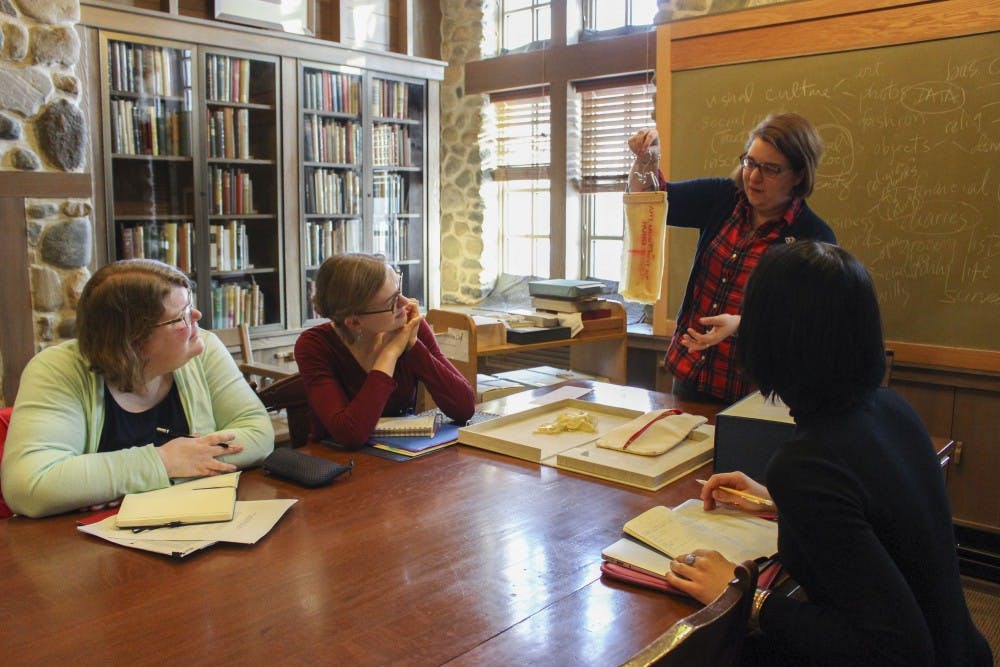Rebecca Baumann, assistant librarian at the Lilly Library, unzipped a red zipper on a white book sleeve that read “Lay text.” Inside was a garment bag with two soggy, drooping latex gloves. Baumann raised up the the book inside, a collection of six leaves of wax paper suspended on a hook.
“Art must not be hung,” the first sheet read.
Founded in 1960, the Lilly Library contains about 400,000 books, 100,000 pieces of music and more than 7.5 million manuscripts, according to the Lilly Library website.
The library contains a Gutenberg Bible, one of the first books to exist in print and one of 22 that still exists, according to the Gutenberg Bible website. The library also contains collections of medieval works, author manuscripts and art.
The book “Lay text” by Angela Lorenz exists in a collection of 40 numbered copies.
“It wins the award for the grossest book in the collection,” Baumann said, after she held up the browning latex gloves.
Baumann teaches ILS-Z681: The Book 1450 to the Present in the Lilly Library. She presented a selection of books that have unconventional construction or push the limit of what can be defined as a book.
One book was a case of multicolored pencils, which appear to simply be colored pencils at first glance.
The pencils each carry a line of a poem, which can be constructed according to the poet’s arrangement or in any way that appeals to the reader.
The pencils contain lines such as, “the lasting dream,” “nothing to do” and “which was it?”
Baumann next presented an average-sized book titled, “Committee Report for the Arts Endowment Funding Comprehensive List of Approved Art from 1990.” The book is hard backed with a purple cover and a giant bolt and padlock in the center of the cover.
“It’s an unreadable book,” Baumann said to the class. “Art is locked down, you guys. This is not approved. You can’t open it.”
The book comes with a key.
“I am fairly confident the key doesn’t work,” Baumann said. “I tried it and tried it. I’m betting that’s part of the interpretation, is that you have the key, but the key doesn’t work.”
Another book Baumann showed the class, an 1820 copy of Giovanni Boccaccio’s “The Decameron,” is thin and elongated with tiny print.
“But why would you ever print a book in this format?” Baumann said. “It’s certainly not a convenient way to read.”
The reason for printing the book has been met with speculation, but nothing is certain. The inside of the book calls itself “papyriform edition.”
Michael Suarez, director of the rare book school at the University of Virginia, proposed the idea that it was created in imitation of Egyptian papyri form, though it is only a guess.
“When the guy who is the biggest name in rare books is befuddled by a book that you own, you’re happy,” Baumann said.
“Mars” by Daniel E. Kelm is a hexagonal artist book that comes in a set with a large ball bearing, a Civil War-era canister ball and a piece of meteorite. These represent the "three faces of Mars," according to IUCAT.
The book itself unfolds in different directions that spell out different words. One way spells out “Mars,” and other ways spell “Aries” and “God of War.” Some hexagons contain images. The book also contains pins that allow it to be built into a 3-D shape.
“This is another good example of an artist book, and an artist has all these deep thoughts and ideas about what it all means,” Baumann said.
Baumann brought out a box and opened it. Inside was a book that read “Hamlet” on the spine in gold lettering.
“This is the only book in the collection that I’m not allowed to touch,” Baumann said. “I can’t open it. I can open the case.”
The book is printed on cork sheets, which makes the turn of a page liable to tear it.
“That’s a question of why, why would you print a book on cork?” Baumann said. “The answer is pretty much to show that you can. But then it becomes this absolutely useless object.”
Among these, the Lilly Library also owns a collection of especially tiny books, multiple of which can fit into the palm of a person’s hand.
“People make these in very limited editions with the very deliberate purpose of challenging the notion of a book,” Baumann said.




